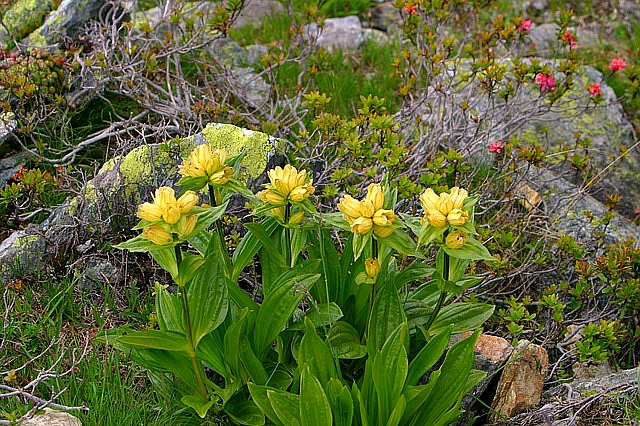Free gardening gloves when you spend $75.00 or more!
What's the difference between a rock and an alpine garden? Well...an alpine is often a rock garden, but a rock garden isn't necessarily an alpine garden. The difference is alpine plants which are typically plants found in mountainous regions.
You might read that alpine rock gardens are declining in popularity, but if you spend any time on social media in the garden world or converse with lots of gardeners, you’d probably find the opposite. Rock gardens are becoming more and more asked about and popular to install, and for great reason. With more attention paid to water-wise gardening, and landscapes that are easy to maintain, alpine gardens are quickly becoming extremely popular.
Rocky alpine gardens are very water-wise. Plants that grow well in alpine conditions and in rocky, sandy areas are often used to drought conditions. They often live in areas that get very hot during the day and very cold at night. They often do well in areas where humidity is low, but planted correctly and alpine gardens can thrive anywhere.
The plants in rock gardens gain much of their nutrition from the very little organic matter available- relying more on the sun and some water, and the trace amounts of nutrients in the soil. In fact, over-feeding plants in a rock garden can be problematic, as these plants do best in very poor soil conditions.
Weeds are easy to suppress in rock gardens. Rock mulch and sandy, nutrient depressed soil isn’t exactly a good place for many plants to grow, and what does take hold in the alpine environment is easy to remove (or poison if you’re careful).
Plants that grow well in rock gardens are beautiful plants. There are many kinds, and planted carefully will offer a season full of amazing form, foliage, and blooms. In fact, alpine garden plants are often some of the showiest of them all and are tough of course. Phlox, dianthus, rosemary, junipers, pines, sedum, nandina, and even hardy roses do well in rock gardens. More unusual customers like yucca, delosperma, cacti, and succulents will also do very well in alpine and rock gardens. Many of these plants stay in nice, neat clumps and don’t grow overly large- making their maintenance almost non-existent.
Installing rock gardens is actually a pretty simple task, and can be done in relatively short time. All alpine and rock gardens require soil that is grainy, gritty, and drains very quickly, and bright full sun (you can create some shelter using shady sides of stones or under larger plants too). Sand and sand mixes make up the base of rock garden beds. If your soil isn’t already sandy, digging down a foot or two, or creating a raised bed and filling it with sand is all you need to do in most areas. If your soil is clay, adding a layer of coarse stone first will help drainage. In areas where your soil is loamy and there’s a lot of organic matter, placing a permeable membrane separating the sandy layer from the soil underneath is a good idea, so the organic matter doesn’t mix with the sand over time.
Once your sand is down, you can add larger stones if you wish. Try to stay consistent with the type of stone you use, and aim for using only local stones, as they will appear the most natural.
After your larger stones are down, you can plant your first alpine plants into their new home. When planting, add a bit of organic matter to the planting holes so the new plants get what they need to establish themselves. Mulch your plants with a layer of natural pea gravel and sand.
Throughout the years, divide plants as necessary, but hold back on the watering and feeding. A yearly assault on weeds might be necessary- which in the alpine garden is a simple task if you use an herbicide making sure to not over spray onto your garden plants.
Alpine and rock gardens are beautiful, easy to maintain, and a wonderful addition to the landscape! VIsit our Rock and Alpine Garden Plants Page for more ideas on plants for you to order for your new rock garden.

- cheryl's blog
- Log in or register to post comments







